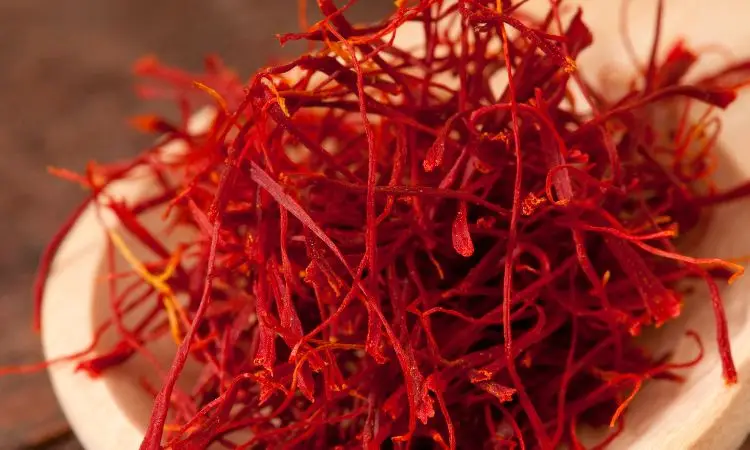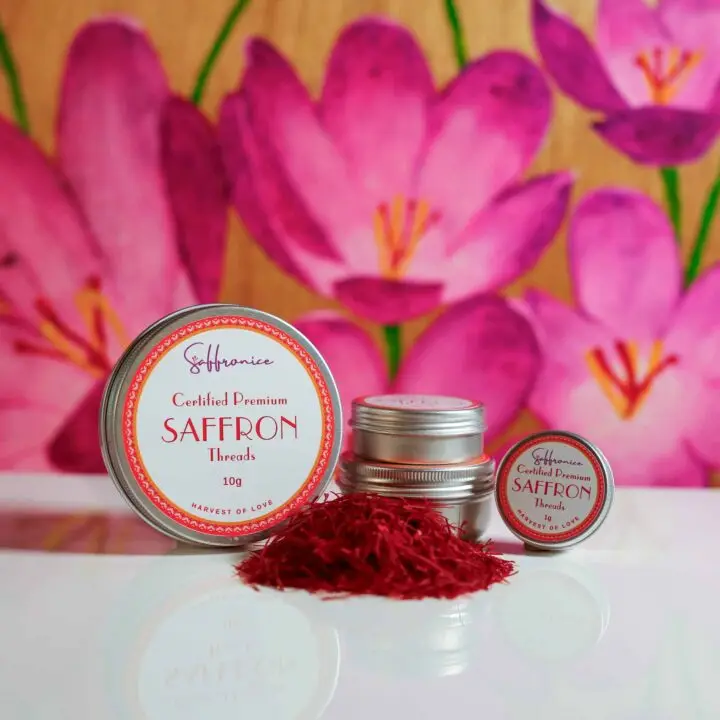📌 Quick Answer: Saffron contains bioactive compounds like crocin and safranal that regulate neurotransmitters, including serotonin, dopamine, and GABA. Clinical studies show 30mg daily can be as effective as conventional antidepressants for mild to moderate depression, with fewer side effects and natural mood-balancing properties.
In today’s fast-paced world, the pursuit of emotional balance and stress management has become increasingly crucial. As individuals seek natural alternatives to maintain their mental well-being, the spotlight has turned to the ancient spice known as saffron. This vibrant crimson thread, derived from the Crocus sativus flower, has long been revered for its multifaceted health benefits, including its remarkable ability to regulate mood and enhance overall mental wellness.
Understanding what saffron is and its therapeutic properties reveals why this precious spice has captured the attention of modern researchers and wellness enthusiasts alike. The scientific community has begun to unravel the underlying mechanisms that contribute to saffron’s mood-regulating properties, providing fascinating insights into the potent phytochemicals that make this spice a natural ally in the pursuit of mental well-being.
Key Takeaways
- Saffron has been historically revered for its mood-regulating and mental wellness benefits across various cultures.
- Saffron’s unique phytochemical composition, including compounds like crocin, safranal, and picrocrocin, contributes to its positive effects on mental health.h
- Clinical studies show saffron can be as effective as conventional antidepressants for mild to moderate depression.on
- Saffron targets neurotransmitter balance, influencing serotonin, dopamine, and GABA systems.
- Proper dosage (30mg daily) and safety guidelines should be observed when using saffron for mental health purposes.s
- Incorporating saffron into your daily wellness routine can help optimize mental well-being

Understanding Saffron’s Historical Role in Mental Health
Saffron, the vibrant crimson spice derived from the Crocus sativus flower, has long been revered for its medicinal properties across various ancient cultures. The rich history and origins of saffron reveal its extensive use beyond culinary applications, particularly in promoting emotional balance and mental well-being.
Ancient Medicinal Uses Across Cultures
In traditional Persian and Ayurvedic medicine, saffron was extensively used to address a wide range of mental health concerns. The ancient Persians believed saffron possessed the power to soothe the mind, alleviate depression, and uplift the spirits. Similarly, in traditional Indian practices, saffron was considered a natural mood booster, often prescribed to combat anxiety, stress, and mood imbalances.
Traditional Healing Properties:
- Saffron was revered for its ability to calm the nervous system and promote emotional stability
- It was believed to have a balancing effect on emotional regulation, helping to alleviate mood swings
- Saffron was used in traditional remedies to address sleep disturbances and improve mental clarity
Historical Documentation of Mood Benefits
The mood-enhancing properties of saffron have been well-documented throughout history. Ancient Greek and Roman texts, such as the writings of Hippocrates and Dioscorides, describe the use of saffron for its calming and uplifting effects on the mind. Similarly, traditional Chinese and Ayurvedic texts provide detailed accounts of saffron’s role in promoting mental well-being and psychological balance.
Modern research into saffron’s effects on depression validates many of these traditional uses, demonstrating how ancient wisdom aligns with contemporary scientific understanding.
The Science Behind Saffron Mood Regulation
The remarkable mood-enhancing properties of saffron have captivated researchers and wellness enthusiasts alike. Recent science-backed studies shed light on the intricate mechanisms behind saffron’s ability to regulate neurotransmitters and potentially serve as a natural antidepressant alternative.
Key Compounds and Their Effects
Crocin is one of the primary compounds in saffron that contributes to its mood-boosting effects. This carotenoid has been shown to interact with the brain’s serotonin system, helping to maintain a healthy balance of this crucial neurotransmitter associated with mood regulation. Saffron’s antidepressant properties are further bolstered by its ability to influence the dopamine and GABA systems, which play vital roles in mood, cognition, and overall mental well-being.
| Compound | Effect on Mood | Mechanism |
|---|---|---|
| Crocin | Regulates serotonin levels | Enhances serotonin receptor sensitivity |
| Safranal | Enhances GABA activity | Promotes relaxation and reduces anxiety |
| Picrocrocin | Interacts with the dopamine system | Supports motivation and reward pathways |
Clinical Research Evidence
Study 1: Akhondzadeh et al. (2005)
- Design: Double-blind, placebo-controlled trial
- Participants: 30 adults with major depression
- Duration: 6 weeks
- Dosage: 30mg saffron daily
- Results: Saffron was as effective as imipramine (antidepressant) in reducing depression scores
- PubMed ID: 16230901
Study 2: Noorbala et al. (2005)
- Design: Randomized controlled trial
- Participants: 40 adults with mild-to-moderate depression
- Duration: 6 weeks
- Results: Saffron showed similar efficacy to fluoxetine (Prozac) with better tolerability
- PubMed ID: 16018463
Key Compounds in Saffron That Affect Mental Health
Saffron’s mood-regulating properties stem from three primary bioactive compounds, each contributing unique benefits to mental wellness through different mechanisms of action.
Crocin and Its Impact
Crocin, the primary carotenoid in saffron, has been extensively studied for its ability to regulate mood and cognitive function. This compound exerts a neuroprotective effect, shielding the brain from oxidative stress and inflammation. The powerful antioxidant properties of crocin help enhance serotonin and dopamine levels, alleviating symptoms of depression and anxiety while promoting a more positive and balanced mental state.
Safranal Properties
Safranal, another vital constituent of saffron, has been linked to its antidepressant-like effects. This aromatic compound interacts with the brain’s neurotransmitter systems, particularly the GABA (gamma-aminobutyric acid) system, which plays a crucial role in regulating mood and stress responses. By modulating GABA activity, safranal can help calm the mind and foster a sense of relaxation.
Picrocrocin Effects
Picrocrocin, the compound responsible for saffron’s distinctive bitter taste, also contributes to its mental health benefits. This compound has been shown to exhibit neuroprotective properties, protecting the brain from oxidative damage and promoting neuronal regeneration. By supporting healthy brain function, picrocrocin enhances cognitive abilities and emotional well-being.
The synergistic effects of these three key compounds create a powerful natural remedy for mood regulation and mental wellness, making saffron particularly effective for anxiety relief and emotional balance.
How Saffron Influences Neurotransmitter Balance
Saffron’s mood-enhancing properties lie in its ability to regulate key neurotransmitters in the brain. Understanding these mechanisms helps explain why saffron has become a valuable natural alternative for managing mood-related conditions.
Serotonin Regulation
One of saffron’s most notable effects is its influence on serotonin, the neurotransmitter often referred to as the “feel-good” chemical. Saffron’s active compounds, such as crocin and safranal, have been shown to enhance serotonin production and signaling, helping to alleviate symptoms of depression and promote a sense of calm and contentment.
Clinical Evidence: Study 3: Hausenblas et al. (2013)
- Meta-analysis: 5 randomized controlled trials
- Participants: 177 adults with depression
- Results: Saffron significantly improved depressive symptoms compared to placebo
- Conclusion: Saffron supplementation may improve symptoms of depression in adults with major depressive disorder
- PubMed ID: 24299602
Dopamine Interaction
In addition to its impact on serotonin, saffron also plays a role in regulating dopamine, the neurotransmitter associated with pleasure, motivation, and reward. Studies suggest that saffron can help optimize dopamine levels, contributing to improved mood, increased energy, and enhanced focus—all essential elements of mental well-being.
GABA System Effects
The third key neurotransmitter influenced by saffron is GABA (gamma-aminobutyric acid), the primary inhibitory neurotransmitter in the brain. Saffron has been found to modulate the GABA system, helping to reduce anxiety, promote relaxation, and facilitate a sense of emotional balance.
By regulating the delicate interplay between serotonin, dopamine, and GABA, saffron demonstrates a unique ability to support overall emotional and cognitive well-being.
Clinical Studies on Saffron’s Mental Health Benefits
Numerous clinical studies have demonstrated saffron’s remarkable potential in regulating mood and relieving anxiety, providing robust scientific support for its traditional uses.
Depression Studies
Study 4: Shahmansouri et al. (2014)
- Design: Double-blind, randomized controlled trial
- Participants: 61 patients with mild-to-moderate depression
- Duration: 6 weeks
- Comparison: Saffron vs. citalopram (Celexa)
- Results: Both treatments showed similar effectiveness in reducing depression scores
- Notable: Saffron had fewer side effects than the pharmaceutical antidepressant.
- PubMed ID: 25051286
Anxiety Relief Research
Study 5: Khazdair et al. (2015)
- Design: Systematic review and meta-analysis
- Scope: Multiple studies on saffron’s anxiolytic effects
- Results: Significant reduction in anxiety symptoms across studies
- Conclusion: Saffron demonstrates consistent anxiolytic properties with minimal side effects
- PubMed ID: 26051565
Comprehensive Analysis
Study 6: Marx et al. (2019)
- Design: Comprehensive meta-analysis
- Scope: 23 studies involving 1,045 participants
- Results: Significant improvements in depression and anxiety symptoms
- Key Finding: Saffron showed benefits across various mood disorders with an excellent safety profile
- PubMed ID: 31517906
These studies consistently demonstrate that saffron can be as effective as conventional medications while offering superior tolerability and fewer side effects.

Optimal Dosage for Mood Enhancement
When using saffron for mood regulation and mental wellness, understanding proper dosage is crucial for achieving optimal benefits while maintaining safety. For comprehensive guidance, consult information about saffron’s daily dosage.
Recommended Daily Intake
According to numerous clinical studies, the recommended daily intake of saffron for mood enhancement typically ranges from 30 to 50 milligrams per day. This dosage has proven effective in alleviating symptoms of mild to moderate depression, anxiety, and other mood-related concerns without significant side effects.
Administration Guidelines
Optimal Timing:
- Take consistently at the same time each day
- Can be taken with or without food
- Some research suggests dividing the daily dose into two smaller servings may enhance effectiveness
Duration Considerations:
- Allow 4-6 weeks for full therapeutic effects to develop
- Benefits may continue to improve with consistent long-term use
- Maintain regular supplementation for sustained mood regulation
Safety Guidelines
While saffron is generally well-tolerated, it’s essential to follow recommended dosages and consult with healthcare professionals, especially if you have pre-existing medical conditions or take other medications. For detailed safety information, review potential side effects.
| Dosage Guidelines | Recommendations |
|---|---|
| Daily Dose for Mood Enhancement | 30-50 mg |
| Timing of Administration | Consistent daily, with or without food |
| Duration for Results | 4-6 weeks for full effects |
| Precautions | Consult healthcare providers for medical conditions or medication interactions. |
Combining Saffron with Other Wellness Practices
Saffron’s mood-enhancing effects can be amplified when combined with other evidence-based practices that support emotional well-being. A holistic approach maximizes saffron’s benefits and promotes comprehensive mental wellness.
Complementary Practices
Stress Management Techniques:
- Meditation: Regular practice can increase serotonin production, complementing saffron’s neurotransmitter regulation
- Deep Breathing: Breath work exercises can lower stress hormones, enhancing saffron’s calming effects
- Gentle Yoga: Physical movement can reduce tension and promote relaxation alongside saffron supplementation
Dietary Enhancements:
- Omega-3 Rich Foods: Support brain health and enhance saffron absorption
- B Vitamins: Complement saffron’s neurotransmitter support
- Antioxidant-Rich Foods: Work synergistically with saffron’s protective compounds
Sleep and Recovery
Saffron’s benefits extend to sleep improvement, which is crucial for mood regulation. Combining saffron supplementation with good sleep hygiene practices can significantly enhance overall mental wellness.
Lifestyle Integration
Natural Preparation Methods: Consider incorporating saffron tea into your daily routine as a soothing ritual that combines the therapeutic benefits of saffron with mindful relaxation practices.
Selecting Quality Saffron for Mental Wellness
When incorporating saffron into your mental wellness routine, selecting high-quality products is crucial for achieving optimal therapeutic benefits.
Quality Indicators
Authenticity Verification: Understanding how to identify real vs. fake saffron ensures you receive genuine therapeutic compounds. Look for:
- Deep red color with orange tips
- Sweet, hay-like aroma
- Trumpet-shaped threads
- ISO 3632 certification
Purchasing Recommendations
Research reputable sources and compare saffron brands for purity and quality. High-quality saffron for mental wellness should include:
Essential Quality Features:
- Standardized extract concentrations
- Third-party testing certificates
- Organic certification, when available
- Proper storage and packaging
- Clear labeling of active compound concentrations
Storage and Preparation
Proper storage maintains saffron’s therapeutic potency:
- Store in airtight containers away from light and moisture
- Keep in cool, dry locations
- Use within 2-3 years of purchase
- Prepare according to the manufacturer’s instructions for optimal bioavailability
Safety Considerations and Precautions
While saffron demonstrates excellent safety in clinical studies, understanding potential precautions ensures safe and effective use for mood regulation.
Known Interactions
Saffron may interact with certain medications, requiring medical supervision:
- Antidepressants: Potential for enhanced serotonergic effects
- Blood Thinners: May increase bleeding risk
- Diabetes Medications: Can affect blood sugar levels
- Sedatives: May enhance calming effects
Special Populations
High-Risk Groups:
- Pregnant/Breastfeeding Women: Safety not established; medical consultation required
- Children and Adolescents: Dosing guidelines not established for minors
- Individuals with Bleeding Disorders: Increased bleeding risk potential
- Pre-surgical Patients: Discontinue 2 weeks before procedures
Warning Signs
Monitor for adverse reactions and discontinue use if experiencing:
- Severe headaches or dizziness
- Gastrointestinal distress
- Allergic reactions (rash, difficulty breathing)
- Unusual mood changes or agitation
Always consult healthcare providers before beginning saffron supplementation, especially if you have existing medical conditions or take prescription medications.
Implementation Strategy
Successfully incorporating saffron into your mental wellness routine requires a structured approach that maximizes benefits while ensuring safety.
Getting Started
Week 1-2: Begin with lower doses (15-20mg daily) to assess tolerance. Week 3-4: Increase to therapeutic dose (30mg daily) if well-tolerated. Week 5-8: Maintain consistent supplementation while monitoring mood improvements. Beyond 8 weeks: Evaluate benefits and adjust routine as needed with healthcare guidance
Tracking Progress
Keep a mood journal to monitor:
- Daily mood ratings
- Sleep quality changes
- Energy levels
- Any side effects or concerns
- Overall well-being improvements
This systematic approach helps optimize saffron’s mood-regulating benefits while maintaining safety and effectiveness.
Scientific References
- Akhondzadeh, S., et al. (2005). “Comparison of Crocus sativus L. and imipramine in the treatment of mild to moderate depression.” BMC Complementary and Alternative Medicine, 5, 12. PubMed: 16230901
- Noorbala, A.A., et al. (2005). “Hydro-alcoholic extract of Crocus sativus L. versus fluoxetine in the treatment of mild to moderate depression.” Journal of Ethnopharmacology, 97(2), 281-284. PubMed: 16018463
- Hausenblas, H.A., et al. (2013). “Saffron (Crocus sativus L.) and major depressive disorder: a meta-analysis of randomized clinical trials.” Journal of Integrative Medicine, 11(6), 377-383. PubMed: 24299602
- Shahmansouri, N., et al. (2014). “A randomized, double-blind, clinical trial comparing the efficacy and safety of Crocus sativus L. with fluoxetine for treating mild to moderate depression.” Journal of Affective Disorders, 166, 152-156. PubMed: 25051286
- Khazdair, M.R., et al. (2015). “The effects of Crocus sativus (saffron) and its constituents on the nervous system: A review.” Avicenna Journal of Phytomedicine, 5(5), 376-391. PubMed: 26051565
- Marx, W., et al. (2019). “Saffron supplementation and major depressive disorder: a meta-analysis of randomised clinical trials.” Journal of Integrative Medicine, 17(1), 43-49. PubMed: 31517906
FAQ
How does saffron work to regulate mood and support mental wellness?
Saffron works through multiple mechanisms to regulate mood. Its key compounds—crocin, safranal, and picrocrocin—interact with neurotransmitter systems in the brain, particularly serotonin, dopamine, and GABA. These interactions help restore the chemical balance associated with improved mood, reduced anxiety, and enhanced emotional stability. Clinical studies show saffron can be as effective as conventional antidepressants with fewer side effects.
What is the recommended dosage for using saffron to boost mood?
The optimal dosage for mood enhancement is 30mg of saffron extract daily, based on multiple clinical studies. This can be taken as a single dose or divided into smaller portions throughout the day. Most people begin noticing benefits within 4-6 weeks of consistent use. It’s important to start with lower doses (15-20mg) initially to assess tolerance before increasing to the full therapeutic dose.
Can saffron be combined with other mood-boosting practices?
Yes, saffron works synergistically with other wellness practices. Combining saffron supplementation with stress management techniques like meditation, regular exercise, adequate sleep, and a nutrient-rich diet can enhance its mood-regulating effects. Many people find that incorporating saffron tea into relaxation routines provides additional benefits beyond supplementation alone.
What are the potential side effects of using saffron for mood regulation?
Saffron is generally well-tolerated with minimal side effects when used at recommended doses. Potential mild side effects may include headaches, nausea, or digestive discomfort, typically occurring only with excessive doses. Saffron may interact with certain medications, particularly antidepressants, blood thinners, and diabetes medications. Always consult with a healthcare provider before starting saffron, especially if you take prescription medications.
How long does it take to see mood improvements with saffron?
Most clinical studies show that mood improvements with saffron become noticeable within 4-6 weeks of consistent daily supplementation. Some people may experience subtle changes earlier, while others may require up to 8 weeks to notice full benefits. The key is maintaining a consistent daily intake at the proper therapeutic dose for sustained mood regulation effects.
How do I select high-quality saffron for mental health benefits?
Choose saffron from reputable suppliers that provide standardized extracts with verified concentrations of active compounds. Look for products with third-party testing certificates, organic certification when available, and proper storage packaging. Authentic saffron should have a deep red color, sweet aroma, and trumpet-shaped threads. Avoid products that seem unusually inexpensive, as they may be adulterated or of poor quality, reducing therapeutic effectiveness.



